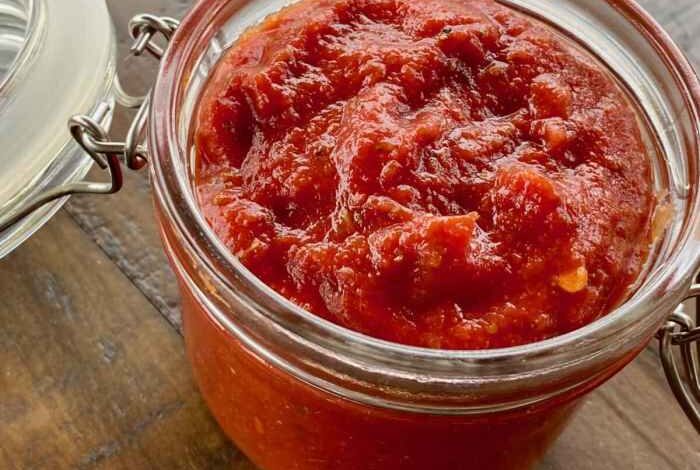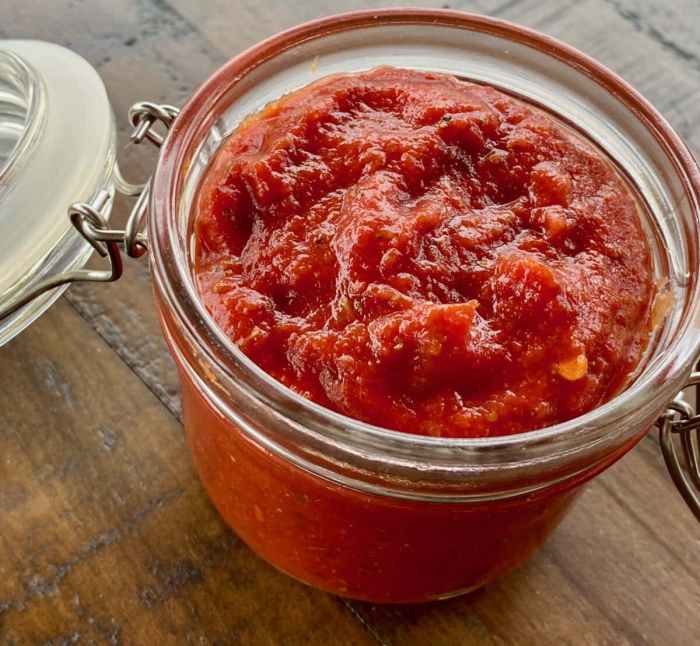
Zesty tomato and orange sauce takes center stage, a symphony of sweet, tart, and savory notes that dance on your palate. This vibrant sauce, bursting with citrusy zest and the richness of tomatoes, is a culinary masterpiece that elevates any dish.
The secret lies in the perfect balance of ingredients, each playing a crucial role in creating a harmonious flavor profile.
From the tangy bite of oranges to the depth of ripe tomatoes, every element contributes to the sauce’s unique character. Whether you’re seeking a bright and refreshing sauce for pasta or a bold and complex accompaniment for grilled chicken, this versatile creation is sure to satisfy your taste buds.
Flavor Profile and Ingredients: Zesty Tomato And Orange Sauce
A zesty tomato and orange sauce is a delightful combination of sweet, tart, and savory flavors that creates a complex and balanced taste. The sweetness comes from the natural sugars in the tomatoes and oranges, while the tartness is provided by the citrus acidity of the oranges.
The savory notes are achieved through the use of herbs, spices, and sometimes even a touch of umami from ingredients like soy sauce or anchovies.
Essential Ingredients
The key ingredients for a zesty tomato and orange sauce are:
- Tomatoes:Tomatoes are the foundation of this sauce, providing its sweetness and body. Choose ripe tomatoes for the best flavor.
- Oranges:Oranges contribute a bright citrus flavor and acidity to the sauce. Use fresh oranges for the best results, and consider using both the juice and zest for a more intense orange flavor.
- Onion:Onions add a subtle sweetness and depth of flavor to the sauce.
- Garlic:Garlic provides a pungent and aromatic flavor that complements the other ingredients.
- Herbs:Fresh herbs like basil, oregano, and thyme add a vibrant and herbaceous aroma to the sauce.
- Spices:Spices such as red pepper flakes, cayenne pepper, or a pinch of cinnamon can add a touch of heat or warmth to the sauce.
- Salt and Pepper:Salt and pepper are essential for balancing the flavors and enhancing the overall taste of the sauce.
Alternative Ingredients
To adjust the flavor profile of a zesty tomato and orange sauce, you can experiment with different ingredients:
- Tomatoes:Use different varieties of tomatoes, such as Roma tomatoes for a richer flavor or heirloom tomatoes for a more complex sweetness.
- Oranges:Substitute oranges with other citrus fruits like lemons, limes, or grapefruit to create different flavor profiles.
- Spices:Experiment with different spices to add warmth, heat, or other flavor nuances. For example, try adding a pinch of cumin, coriander, or ginger.
Cooking Techniques
Crafting a zesty tomato and orange sauce is a culinary journey that blends vibrant flavors and textures. The process involves a harmonious interplay of chopping, sautéing, simmering, and reducing, each step contributing to the sauce’s final character.
That zesty tomato and orange sauce I made last night was a real hit! It’s so versatile, I could see myself using it on everything from pasta to chicken. Speaking of versatility, have you ever considered hardwiring a light fixture?
It’s a great way to add some extra lighting to your home, and it’s not as complicated as you might think. You can find some helpful tips on how to hardwire a light fixture. Anyway, back to the sauce – I think I’ll make a double batch next time, just to be safe!
Achieving the Desired Texture and Flavor
The success of this sauce hinges on precise cooking times and temperatures. Sautéing the aromatics, such as onions and garlic, over medium heat for a few minutes unlocks their fragrant oils, creating a foundation for the sauce’s depth. Simmering the tomatoes and orange juice gently for an extended period allows the flavors to meld and the sauce to thicken naturally.
The tangy sweetness of a zesty tomato and orange sauce always reminds me of cozy evenings spent curled up with a good book. Speaking of cozy, have you seen those amazing holiday themed book nooks popping up everywhere? They’re the perfect place to enjoy a delicious meal, like a pasta dish with that zesty sauce, while getting lost in a captivating story.
Reducing the sauce further intensifies its flavor and creates a luscious consistency.
The zesty tomato and orange sauce was the perfect complement to the roast chicken, a burst of flavor that brightened up the entire meal. It reminded me of the fiery spirit of Princess Margaret, so brilliantly portrayed by the award-winning actresses in The Crown.
Like the sauce, Princess Margaret was a complex character, full of contradictions and unexpected depths, and the actresses who brought her to life were simply phenomenal. Back to the sauce, I can’t wait to try it with a different protein next time!
- Sautéing:This step involves cooking aromatics, such as onions, garlic, and ginger, in a hot pan with a small amount of oil. The goal is to soften the aromatics and release their flavors without browning them too much. Sautéing typically takes 5-10 minutes, depending on the quantity of ingredients and the heat of the pan.
- Simmering:Simmering is a gentle cooking method that involves maintaining a low, steady heat. It’s ideal for sauces, stews, and soups, as it allows flavors to develop slowly and evenly. Simmering typically takes 30-60 minutes, depending on the recipe and desired consistency.
- Reducing:Reducing a sauce involves simmering it over medium heat until it thickens and concentrates. This process intensifies the flavors and creates a richer, more intense sauce. Reducing typically takes 15-30 minutes, depending on the desired consistency and the amount of liquid being reduced.
Enhancing the Zestiness
To elevate the sauce’s zesty character, incorporate citrus zest, fresh herbs, or a pinch of chili flakes.
- Citrus Zest:The zest of an orange or lemon adds a bright, aromatic layer to the sauce. Use a microplane grater to obtain fine zest, ensuring a subtle yet noticeable citrus flavor.
- Fresh Herbs:Aromatic herbs like basil, oregano, thyme, or rosemary complement the sauce’s zesty notes. Add them towards the end of cooking to preserve their freshness and vibrant flavors.
- Chili Flakes:A pinch of chili flakes adds a subtle warmth and complexity to the sauce. Adjust the amount based on your desired level of heat.
Sauce Variations and Applications

This zesty tomato and orange sauce is incredibly versatile and can be adapted to suit a variety of tastes and culinary needs. You can tweak the sweetness, spice level, and texture to create a sauce that perfectly complements your dish.
Sauce Variations
The base recipe provides a good starting point, but there are many ways to customize it to suit your preferences. Here’s a table outlining some variations:
| Variation | Sweetness | Spice Level | Texture |
|---|---|---|---|
| Classic | Medium | Mild | Smooth |
| Sweet and Tangy | High | Mild | Smooth |
| Spicy Kick | Medium | High | Smooth |
| Chunky and Zesty | Medium | Mild | Chunky |
Sauce Applications
This sauce is a wonderful addition to a variety of dishes. Here are some ideas:
- Pasta:Toss it with your favorite pasta, such as spaghetti, penne, or fettuccine. Add some cooked chicken or shrimp for a complete meal.
- Chicken:Use it as a glaze for roasted chicken, or as a sauce for chicken breasts or thighs.
- Fish:It pairs well with grilled or baked fish, such as salmon, cod, or halibut.
- Vegetables:It can be used to create a flavorful sauce for roasted vegetables, such as broccoli, carrots, or asparagus.
- Tacos:This sauce adds a burst of flavor to tacos, both soft and hard shell.
Zesty Tomato and Orange Glazed Salmon, Zesty tomato and orange sauce
This recipe showcases the sauce’s versatility and creates a delicious and visually appealing meal.
Ingredients:
- 1 pound salmon fillet, skin on
- 1/2 cup zesty tomato and orange sauce
- 1 tablespoon olive oil
- Salt and pepper to taste
- Fresh parsley for garnish
Instructions:
- Preheat oven to 400 degrees F (200 degrees C).
- Place the salmon fillet in a baking dish.
- Drizzle the salmon with olive oil and season with salt and pepper.
- Pour the zesty tomato and orange sauce over the salmon, making sure it’s evenly coated.
- Bake for 15-20 minutes, or until the salmon is cooked through and flaky.
- Garnish with fresh parsley and serve immediately.
Culinary History and Cultural Influences

The zesty tomato and orange sauce, with its vibrant flavors and versatility, has a rich history deeply intertwined with the culinary traditions of various cultures. Its evolution reflects the exchange of ideas and ingredients across continents, showcasing the fascinating interplay of taste and history.
Early Influences and Origins
The origins of this sauce can be traced back to the ancient civilizations of the Mediterranean region, where tomatoes and oranges were cultivated and incorporated into various dishes. While the exact combination of these ingredients may have emerged later, the individual components have long histories in culinary traditions.
- Tomatoes:Native to the Andes region of South America, tomatoes were introduced to Europe by Spanish conquistadors in the 16th century. They were initially viewed with suspicion due to their resemblance to poisonous nightshades, but eventually gained popularity as a culinary staple.
In Italy, tomatoes became a key ingredient in sauces, soups, and stews, and the iconic Italian tomato sauce, a foundation for many dishes, emerged during this period.
- Oranges:Oranges, native to Southeast Asia, were introduced to the Mediterranean region by Arab traders during the Middle Ages. They were prized for their sweetness and citrusy flavor, and were incorporated into various cuisines, including desserts, beverages, and sauces.
Cultural Significance and Regional Variations
The zesty tomato and orange sauce has found its way into various cuisines worldwide, often reflecting the unique cultural preferences and culinary traditions of different regions.
- Mediterranean Cuisine:In the Mediterranean region, where tomatoes and oranges are abundant, the sauce is often used to enhance the flavors of fish, seafood, and poultry dishes. The combination of sweetness from the oranges and acidity from the tomatoes creates a harmonious balance that complements the delicate flavors of Mediterranean cuisine.
- Latin American Cuisine:In Latin America, where tomatoes and oranges are staples, the sauce is often used in dishes like ceviche, a Peruvian dish of raw fish marinated in citrus juices, and in various stews and casseroles. The sauce adds a tangy and zesty flavor profile to these dishes, reflecting the vibrant and bold flavors of Latin American cuisine.
- Asian Cuisine:In Southeast Asia, where oranges are native, the sauce has found its way into various dishes, including stir-fries and noodle dishes. The citrusy notes of the orange complement the savory flavors of Asian cuisine, adding a bright and refreshing element to the dishes.
Historical Examples and Influences
The zesty tomato and orange sauce draws inspiration from historical culinary traditions, particularly those that feature citrus fruits and tomatoes.
- Ancient Roman Cuisine:The Romans were known for their use of garum, a fermented fish sauce, and other fermented sauces that were used to enhance the flavors of their dishes. These sauces often included ingredients like vinegar, herbs, and spices, similar to the components of the zesty tomato and orange sauce.
- Medieval European Cuisine:During the Middle Ages, citrus fruits were highly prized in Europe, and were often used in sauces and stews. These sauces often included a combination of sweet and sour flavors, similar to the zesty tomato and orange sauce.
- Renaissance Cuisine:The Renaissance period saw a renewed interest in classical Roman cuisine, and the use of tomatoes and oranges in sauces became more widespread. The combination of these ingredients, along with herbs and spices, created a new wave of culinary innovation that influenced the development of the zesty tomato and orange sauce.

